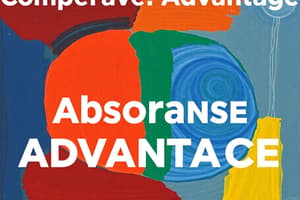Podcast
Questions and Answers
The Production Possibilities Curve shows the maximum possible output of the good that can be produced with available ______, given the output of the alternative good.
The Production Possibilities Curve shows the maximum possible output of the good that can be produced with available ______, given the output of the alternative good.
resources
Opportunity cost refers to the value of the next best ______ that is given up when a choice is made.
Opportunity cost refers to the value of the next best ______ that is given up when a choice is made.
alternative
In trade, a country has a comparative advantage if it can produce a good at a ______ opportunity cost than another country.
In trade, a country has a comparative advantage if it can produce a good at a ______ opportunity cost than another country.
lower
Absolute advantage refers to the ability of a party to produce more of a good or service with the same amount of ______ as another party.
Absolute advantage refers to the ability of a party to produce more of a good or service with the same amount of ______ as another party.
Specialization allows workers to focus on specific tasks, increasing ______ and efficiency in production.
Specialization allows workers to focus on specific tasks, increasing ______ and efficiency in production.
The more specialized a worker becomes, the higher the opportunity cost of transferring them to a different line of ______.
The more specialized a worker becomes, the higher the opportunity cost of transferring them to a different line of ______.
Technology is crucial as it provides the knowledge on how to produce goods and ______.
Technology is crucial as it provides the knowledge on how to produce goods and ______.
Economic resources are categorized into labor, capital, and ______ resources, which are used in production.
Economic resources are categorized into labor, capital, and ______ resources, which are used in production.
The production possibilities curve can shift if there is an improvement in ______ or an increase in resources.
The production possibilities curve can shift if there is an improvement in ______ or an increase in resources.
During the production process, some inputs are better adapted to producing one product than to another, showing the principle of ______.
During the production process, some inputs are better adapted to producing one product than to another, showing the principle of ______.
Flashcards are hidden until you start studying
Study Notes
David Ricardo's Principles of Trade
- Countries can benefit from trade even if one is more efficient in all goods (absolute advantage), due to differences in relative efficiency.
- Specialization based on comparative advantage leads to mutual benefits in trade, as illustrated by the example of two men on an isolated island.
Production Efficiency
- Division of Labor: Involves breaking down a large process into specialized tasks, enhancing proficiency and mass production.
- Technological Advances: New methods and equipment can significantly boost an economy's productive potential and drive economic growth.
- Resource Utilization: The production possibilities curve explains the impact of mismanaged resources and the importance of achieving production efficiency.
Sources of Economic Growth
- Increased Resources: Expanding labor, capital, and natural resources enhances overall production potential.
- Resource Quality: Improving labor force skills and education increases productivity and quality of resources.
- Technological Progress: New production techniques are vital drivers of economic growth and productivity enhancement.
Measuring Economic Growth
- GDP Growth: Economic growth is measured as the rate of increase in real GDP, reflecting the expansion of production possibilities.
Increasing Opportunity Cost
- Law of Increasing Costs: The opportunity cost rises as more of a good is produced, due to resource specialization.
Globalization and International Trade
- Opportunity Cost: Nations benefit from importing goods if the cost of production domestically is higher than the cost of importing.
- Principle of Comparative Advantage: Specializing in goods with lower opportunity costs increases overall consumption capabilities for countries.
- Mutual Gains: Trading partners benefit when they focus on producing goods in which they hold a comparative advantage.
Law of Absolute Advantage
- Definition: The ability to produce more of a good than competitors using the same resources.
- Implications: If a party has no absolute advantage, no trade may occur; however, trade gains may not be mutually beneficial.
- Example: A country may have an absolute advantage in producing more parts per hour compared to others.
Law of Comparative Advantage
- Definition: Two countries benefit from trade when they have different relative costs for producing the same goods, enabling them to specialize.
Production Possibilities and Opportunity Cost
- Economic Inputs: Labor, capital, natural resources, and entrepreneurship drive production and economic growth.
- Definition of inputs and outputs: Production utilizes labor and resources to create goods/services, with technology playing a key role in efficiency.
Production Possibilities Curve
- Shows the maximum output possible for goods with available resources and alternative goods over time.
- Specialized Inputs: Some inputs are suited for specific products, making specialization essential but costly in terms of opportunity for resource transfer.
Studying That Suits You
Use AI to generate personalized quizzes and flashcards to suit your learning preferences.




